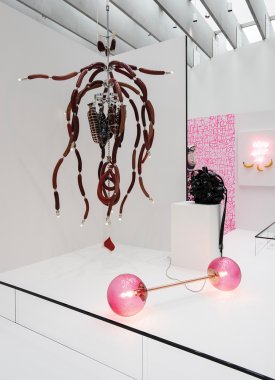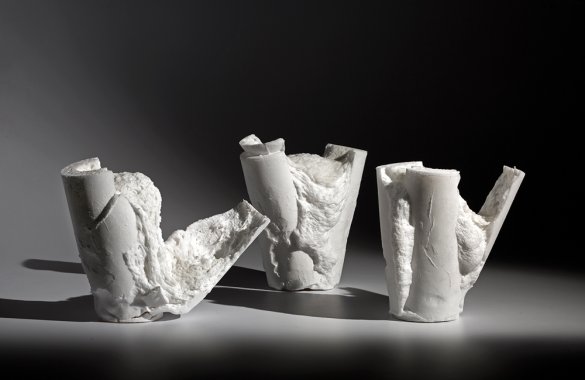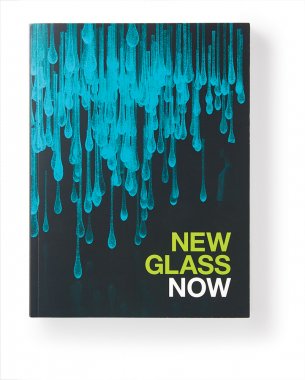New Year, New Glass
New Year, New Glass
Every year since 1979, the Corning Museum of Glass in Corning, New York, publishes New Glass Review, an exhibition-in-print showcasing 100 compelling and innovative works of contemporary glass art from around the world. As an annual snapshot of the glass scene, each publication provides valuable documentation of thought and expression in the field at that time. To celebrate the 40th-anniversary issue, the museum has brought it to life as a physical exhibition on view until January 5.
New Glass Now, as the book and show are titled, presents works by artists from 32 countries, chosen from more than 1,400 open-call submissions. Susie J. Silbert, the Corning’s curator of modern and contemporary glass, worked with three guest “selectors” (Silbert prefers that word to “juror,” which she says “denotes a binary, like good-bad, in-out.”): Aric Chen, curator-at-large, M+ museum of visual culture, Hong Kong; Susanne Jøker Johnsen, head of exhibitions, the Royal Danish Academy of Fine Arts Schools of Architecture, Design, and Conservation, Copenhagen; and Beth Lipman, artist and American Craft Council Fellow, Sheboygan Falls, Wisconsin. The result is a breathtaking display of form, technique, and vision, from vessels and wall pieces to conceptual sculpture and performance, that demonstrates the state of glass art in 2019. For historical perspective, the museum also has a companion show, “New Glass: Context,” which looks back at two landmark Corning exhibitions: “Glass 1959” and 1979’s “New Glass: A Worldwide Survey.”
We talked with Silbert about how New Glass has reflected and influenced the glass field.
What trends and themes emerged in curating this show?
How artists are dealing with contemporary issues. Folks like Deborah Czeresko, Suzanne Peck, and Karen Donnellan of the US, Doris Darling of Austria, Fredrik Nielsen of Sweden, and the American team of Ross Delano, Erikh Vargo, and Brad Patocka are dealing with gender in glassworking –how the community is or isn’t inclusive – and proposing ways to reapproach the space of making in glass. Similarly, the work of Tamás Ábel of Hungary is one of the first times queer issues have been highlighted in a major glass context.
The exhibition also highlights a return to the materiality of glass in a way we haven’t seen since the ’70s. Then, artists were making glass from raw materials because there was nothing else available, and they had a hunger for color and workability. Today, artists like Karina Malling of Denmark, Swedish artist Karin Forslund, and Americans Miya Ando and Nick Fruin are going back to the base material of glass to figure out how, through its very formulation, they can create meaning.
Another exciting thing about the show is that it marks the first time there has been a glass marijuana pipe [by David Colton, US] in the Corning Museum. I think it’s important that that incredible community of makers is represented. I hope to do an exhibition on contemporary pipes in years to come.
Did you notice distinct approaches from different parts of the world?
The exhibition highlights national flavors still evident in glassmaking communities, but also the way these communities are interlinked. For instance, Australians have such an incredible sensitivity to surface, more than perhaps any other glassworkers in the world. You see that not just in the work of Australians like Mel Douglas, Kate Baker, or Judi Elliott, but of people who have spent time in Australia, like American Matthew Day Perez, or Nadège Desgenétez, who is French but teaches in Australia.
What is the review process for New Glass like?
The selectors come to the Corning, where every submission gets viewed multiple times. Ultimately, there doesn’t need to be full consensus. So there are layers of diverse perspectives, which are identified in the catalog and exhibition labels with their initials. Some pieces have only one person’s initials; others have all four, or any mix in between. What I hope that does is pull back the layers, to allow visitors and readers to get a sense of the different selectors’ ways of viewing – and by extension, to have the license not to like everything.
You’re offering more transparency.
Totally. I wish I could say that’s something I came up with, but it was the idea of the museum’s founding director, Thomas Buechner. Every New Glass exhibition and publication since 1959 has included the initials of the selectors.
It’s a milestone year for the Corning.
Huge. Sixty years of commitment to contemporary glass. What’s amazing to me is, it continues. Every day I feel like I’m learning this in a new and more profound way.
The Corning’s “Glass 1959” show, which was eight years after the museum was founded, really created the field of contemporary glass. Before that, it was individual makers and designers in their ateliers around the world. There was no cohesive conversation about glass. It was out of that incredible grouping of objects and people in ’59 that the groundwork for the studio glass movement was laid. Then in 1979, “New Glass: A Worldwide Survey” catapulted it around the world. It’s an exciting history to stand on.




